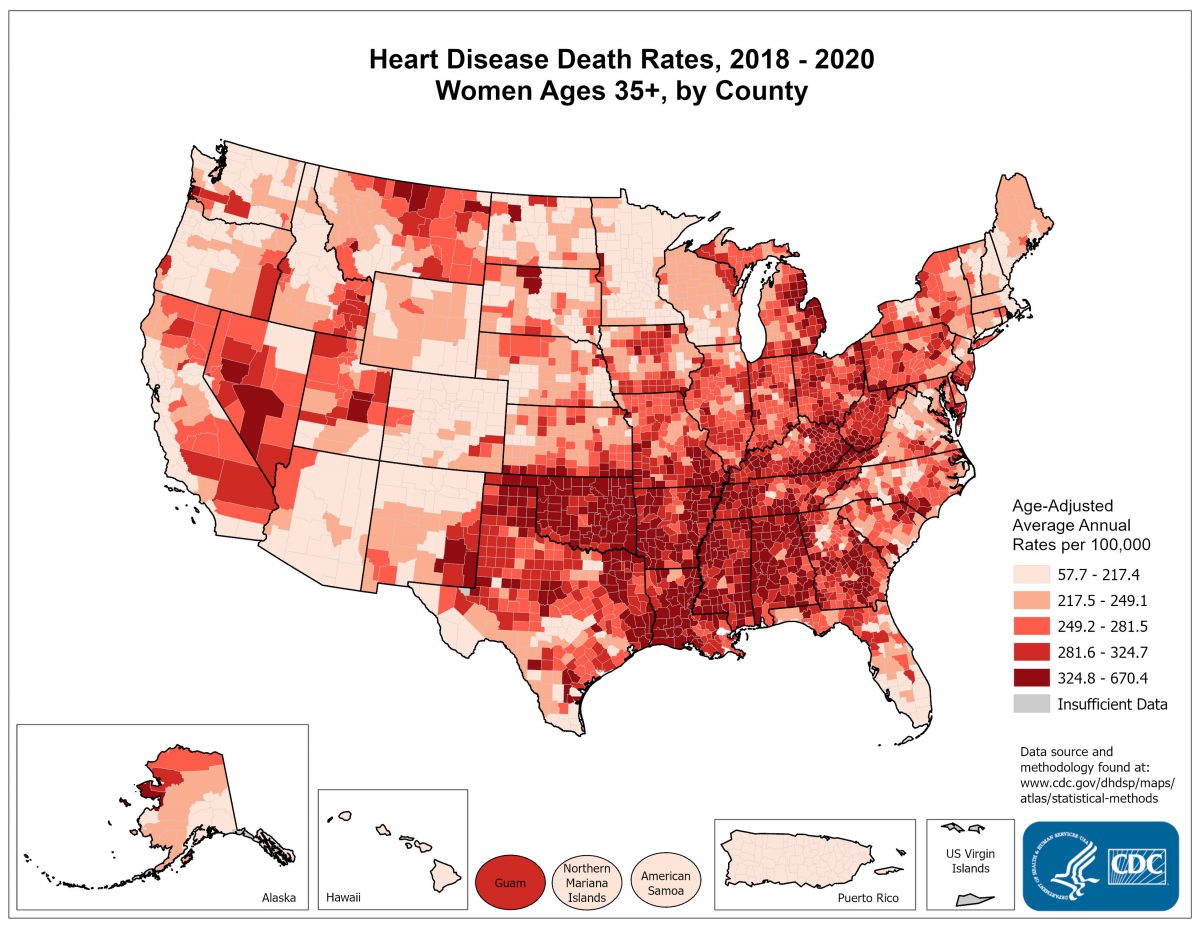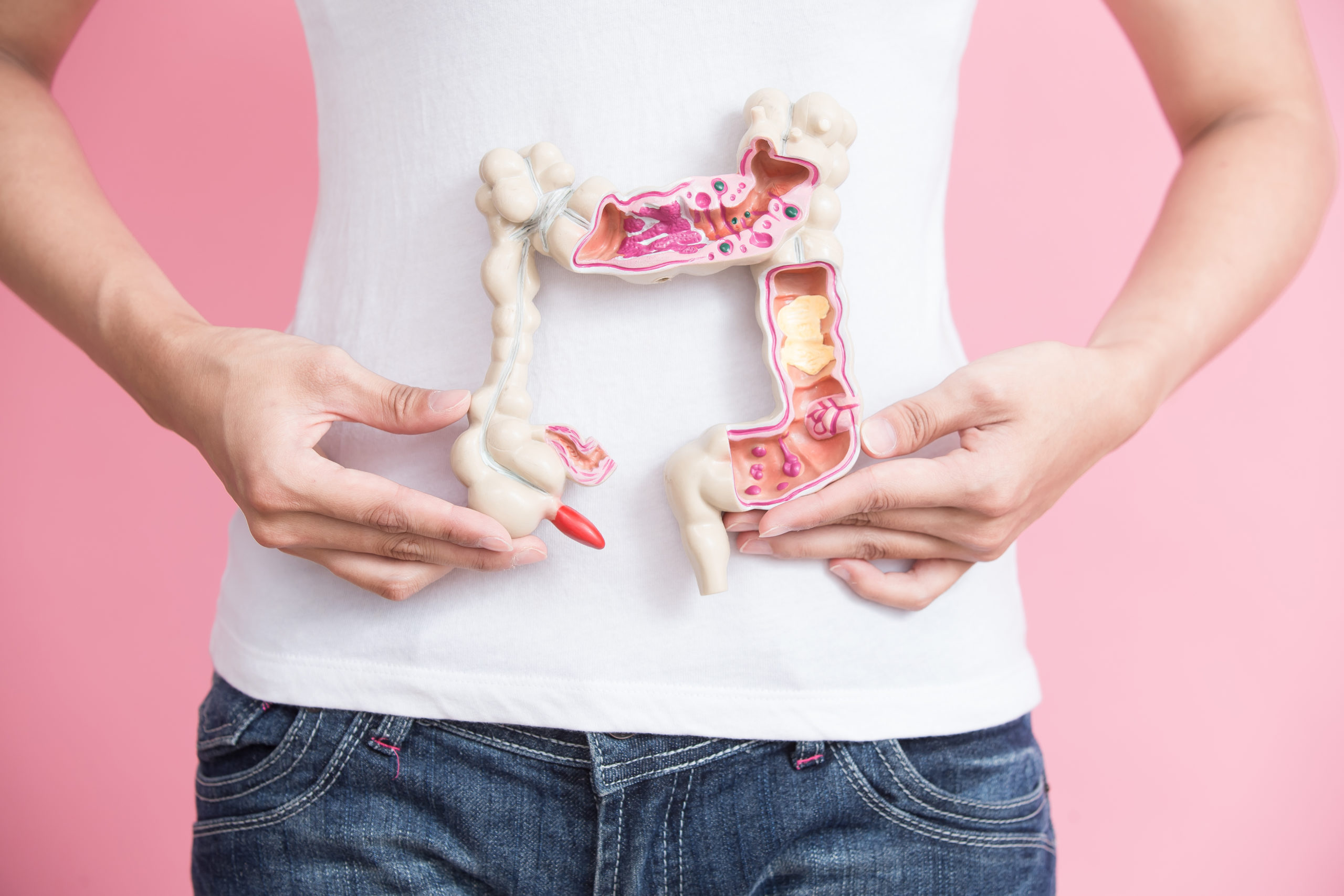
February is American Heart Month: Women and Heart Disease
February is American Heart Month! In this post, we will be sharing information on women and heart disease. Continue reading below to find answers to the following questions:
- How does heart disease affect women?
- What are the symptoms?
- What are the risk factors?
- How can I reduce my risk?
Women and Heart Disease
The term heart disease refers to several types of heart-related conditions, including coronary artery disease (CAD) and heart attack (also called myocardial infarction).
Although this medical condition is sometimes thought of as a man’s disease, almost as many women as men die each year of heart disease in the United States.
This map shows death rates from heart disease in women in the United States. The darker red indicates a higher death rate.
The map shows that concentrations of counties with the highest heart disease death rates – meaning the top quintile – are located primarily in Alabama, Mississippi, Louisiana, Arkansas, Oklahoma, Georgia, Kentucky, and Tennessee. Pockets of high-rate counties also were found in Michigan, Ohio, West Virginia, Virginia, North Carolina, South Carolina, Missouri, Texas, Nevada, and Montana.
Source: Interactive Atlas of Heart Disease and Stroke
How does heart disease affect women?
Despite increases in awareness over the past decades, only about half (56%) of women recognize that heart disease is their number 1 killer.
Learn more facts about women and heart disease:
- – Heart disease is the leading cause of death for women in the United States, killing 314,186 women in 2020—or about 1 in every 5 female deaths.
- – It is the leading cause of death for African American and white women in the United States. Among American Indian and Alaska Native women, heart disease and cancer cause roughly the same number of deaths each year. For Hispanic and Asian or Pacific Islander women, heart disease is second only to cancer as a cause of death.
- – About 1 in 16 women age 20 and older (6.2%) have coronary artery disease, the most common type of heart disease:
- – About 1 in 16 white women (6.1%), black women (6.5%), and Hispanic women (6%)
- – About 1 in 30 Asian women (3.2%)
What are the symptoms?
Although some women have no symptoms, others may have
- – Angina (dull and heavy or sharp chest pain or discomfort)
- – Pain in the neck, jaw, or throat
- – Pain in the upper abdomen or back
These symptoms may happen when you are resting or when you are doing regular daily activities. Women also may have other symptoms, including
- – Nausea
- – Vomiting
- – Fatigue
Sometimes this medical condition may be “silent” and not diagnosed until you have other symptoms or emergencies, including
- – Heart attack: Chest pain or discomfort, upper back or neck pain, indigestion, heartburn, nausea or vomiting, extreme fatigue, upper body discomfort, dizziness, and shortness of breath
- – Arrhythmia: Fluttering feelings in the chest (palpitations)
- – Heart failure: Shortness of breath, fatigue, or swelling of the feet, ankles, legs, abdomen, or neck veins
If you have any of these symptoms, call 9-1-1 right away.
What are the risk factors?
High blood pressure, high LDL (low-density lipoprotein) cholesterol, and smoking are key risk factors for heart disease. About half of all people in the United States (47%) have at least one of these three risk factors.
Several other medical conditions and lifestyle choices can also put people at a higher risk, including
- – Diabetes
- – Having overweight or obesity
- – Eating an unhealthy diet
- – Physical inactivity
- – Drinking too much alcohol
How can I reduce my risk of heart disease?
To lower your chances of getting this medical condition, it’s important to do the following:
- – Know your blood pressure. Having uncontrolled blood pressure can lead to heart disease. High blood pressure has no symptoms, so it’s important to have your blood pressure checked regularly. Learn more about high blood pressure.
- – Talk to your doctor or health care team about whether you should be tested for diabetes. Having uncontrolled diabetes raises your risk. Learn more about diabetes.
- – Quit smoking. If you don’t smoke, don’t start. If you do smoke, learn ways to quit.
- – Discuss checking your blood cholesterol and triglycerides with your doctor. Learn more about cholesterol.
- – Make healthy food choices. Having overweight or obesity raises your risk. Learn more about overweight and obesity.
- – Limit how much alcohol you drink to one drink a day. Learn more about alcohol.
- – Manage stress levels by finding healthy ways to cope with stress. Learn more about coping with stress.
More Information
CDC’s Related Public Health Efforts
For more information on women and heart disease, visit the following websites:
- – U.S. Department of Health and Human Services (HHS), Office on Women’s Health (OWH)
- – American Heart Association
- – National Heart, Lung, and Blood Institute (NHLBI)
Note: Source: CDC. Reference to specific commercial products, manufacturers, companies, or trademarks does not constitute its endorsement or recommendation by the U.S. Government, Department of Health and Human Services, or Centers for Disease Control and Prevention. This material is otherwise available on the agency website for no charge.
More information on other national health observances and medical conditions can be found in our blog. Check out these posts to learn more:
Interested in learning more about a nutraceutical formulated specifically to help with arterial health? Read this post on Arterosil HP and visit our online wellness store to get started. Have questions? Please contact our office directly.
Connect With Us
Check our blog regularly for new posts and follow us on Facebook and Instagram @PeterMLotzeMD for health and wellness tips and more!




